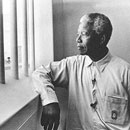Nelson Rolihlahla Mandela was born in Qunu, South Africa, on July 18, 1918, and Nelson Mandela dead 95 years later was buried there, on December 5, 2013. The South African hero filled the years between with service to others, unending dedication to racial equality, and a life that has inspired hundreds of thousands, if not millions of people.
After months out of public sight, people asked, “Is Nelson Mandela dead?” Upon learning of his critical illness, they speculated, “What will we do when Nelson Mandela dies?” Then, the announcement came, answering affirmatively to questions asking, “Did Nelson Mandela die?”
When, at home surrounded by family, including ex-wife Winnie, he succumbed to a respiratory infection that he had battled for months, Nelson Mandela’s death date made news around the world. Headlines globally exclaimed, “Nelson Mandela Dies in Johannesburg”, “Nelson Mandela Dead at 95″, and “World Mourns Nelson Mandela’s Death”, inspiring incredulous inquiries whether news of Nelson Mandela’s death was true and worried wondering about the impact of this loss upon the world.
News of his death extended out of this world, too, reaching the International Space Station. A couple days before Mandela’s funeral, NASA astronaut Rick Mastracchio tweeted, “From the ISS we say goodbye to Nelson Mandela”, along with an image of Cape Town taken from more than 250 miles up by the International Space Station. News of his death reached around the world to Trinidad and Tobago. The islands’ government announced that a day early in 2014 would be declared Mandela Day in honor of the death of the Nobel Peace Prize winner and in celebration of his life.
Watch the official breaking news of his passing:
This new holiday should not be confused with the international Mandela Day, first celebrated in 2009, that occurs annually on his birthday. The day honors Mandela’s commitment to service to others by requesting people set aside 67 minutes to dedicate to another person or a cause. Since his death, many South Africans have advocated for the day to be made an official national holiday.
After the Nelson Mandela death date of December 5, 2013, South Africa entered a 10-day mourning period. In the first few days following his death, elders from the Thembu tribe, the tribe that raised Mandela under the name of Madiba, performed a private “closing of the eyes ceremony”, helping his spirit transition to the afterlife. Flags flew at half-mast on all government buildings. Mourners viewed his body on display for three days in the Union Buildings. Attended by family, president and cabinet, and other dignitaries, and broadcast publicly on television up to the point of burial, his funeral in Qunu marked the end of the official state mourning period, but not the end to the world’s mourning of the loss.
On the South African Day of Reconciliation, a public holiday observed annually on December 16 and coincided this year as the day after Mandela’s funeral, the South African president unveiled a giant statue of Mandela at the Union Buildings in Pretoria, the seat of government. Here, Mandela fought decades of apartheid, and here, also, was where Mandela served as the first black president, democratically elected in the country’s first election allowing all races to vote. It is here that Mandela’s image and vision will remain symbolically.
So is it true, did Nelson Mandela die? The answer is yes, and the answer is no. Is Nelson Mandela dead? In his physical form, yes, he is dead. When did Nelson Mandela die in body? The answer is a day to be remembered. When did Nelson Mandela die, in spirit? Hopefully, that will remain unanswered as Mandela’s legacy continues to live on.




